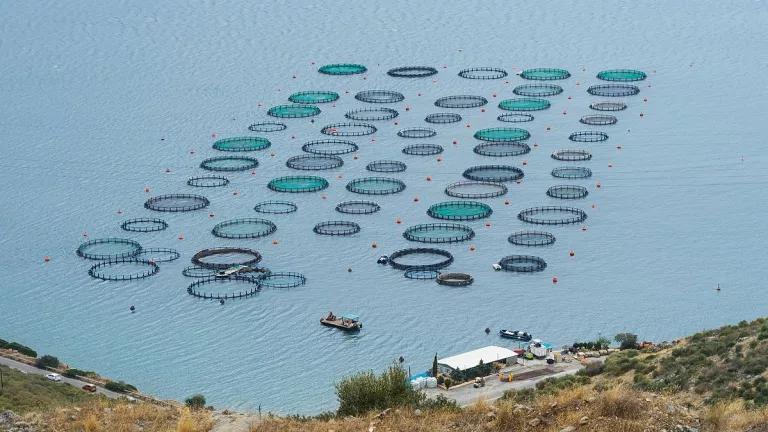Let's Determine the Risks of Open Ocean Finfish Aquaculture
Until we know more about the impacts of open ocean finfish aquaculture, the federal government should take a cautious, research-based approach before greenlighting new projects.

Fish farming near Amarynthos, Euboea, Greece.
The Trump Administration is ramping up efforts to establish finfish aquaculture in the open ocean, despite a lack of evidence that development of this industry will be safe for marine ecosystems and wildlife. Before rushing to institute this unvetted industry, government regulators need to take a hard look at its potential impacts on our oceans.
The National Oceanic and Atmospheric Administration (NOAA) plans to jumpstart an offshore aquaculture industry in the United States by designating ten Aquaculture Opportunity Areas around the country over the next five years. The federal government will fast-track permitting for up to five facilities in each area. NOAA selected Southern California and the Gulf of Mexico as the first two Aquaculture Opportunity Areas and recently sought public comment on the best locations for aquaculture in these regions. NRDC commented on the proposal, advocating for a cautious, fact-based approach.
Finfish aquaculture—the cultivation of bony fish species like yellowtail or salmon—has not been thoroughly researched or tested in the open ocean. Globally, very few aquaculture facilities have operated farther than four miles from shore. Scientists and policymakers have serious concerns about the environmental impacts of large offshore fish farms that are of a scale capable of competing with other seafood sources. Rough water conditions and high-intensity storms in the open ocean are likely to damage net pens, allowing fish to escape. Escaped fish can harm wild fish populations by out-competing them for food, spreading disease, and polluting wild gene pools. Fish waste and other outflows from net pens pollute the water and may aggravate harmful algal blooms. These effects would hurt coastal and fishing communities, which rely on healthy wild fish populations and marine ecosystems.
Marine mammals are potentially at risk of serious injury or death from entanglement on net pen mooring systems or on discarded fishing gear and trash that may become entwined with mooring ropes. Some aquaculture facilities also use acoustic marine mammal deterrents, which can harass whales and other wildlife. These effects are especially concerning in the Gulf of Mexico and Southern California—NOAA’s proposed locations for the first two Aquaculture Opportunity Areas. The Gulf of Mexico whale is one of the most endangered species on the planet and the approximately 33 remaining individuals spend their lives in the De Soto Canyon, west of the Florida panhandle. Southern California provides crucial foraging grounds and migratory corridors for humpback, blue, and gray whales. Siting finfish aquaculture in these habitats will potentially expose vulnerable whales to additional noise, vessel traffic, and entanglement risk.
Claims that offshore finfish aquaculture is a sustainable way to feed a growing world population are overstated. In fact, because operating in the open ocean is expensive, offshore fish farms are likely to cultivate carnivorous species with high market value. Instead of providing cheap and sustainable protein, the fish produced will likely be available mainly to higher-income consumers. Furthermore, harvesting large numbers of smaller fish to feed the farmed fish species reduces a food source for wild fish populations and marine wildlife, putting stress on marine ecosystems. Alternative plant- or poultry-based feeds, if used on a large scale, will consume high levels of land and water.
Despite serious concerns over the impacts of open ocean fish farms, federal agencies continue to rush to advance finfish aquaculture. Recently, the Army Corps of Engineers proposed a Nationwide Permit that would streamline the approval process for these facilities. NRDC commented and raised concerns about the use of nationwide permits for aquaculture facilities, which could take many different forms and have distinct effects at each project site that cannot be accounted for by a generalized permitting process. The Environmental Protection Agency also issued a Clean Water Act NPDES permit for the Velella Epsilon pilot project in the Gulf of Mexico, and NOAA initiated environmental review for the Pacific Ocean AquaFarms facility off the coast of San Diego, California. Pacific Ocean AquaFarms plans to install 28 pens covering 717 acres—an area the size of 540 football fields. This would be the first commercial-scale fish farm in federal waters. NRDC commented on the proposed Pacific Ocean AquaFarms facility, urging NOAA to consult with ocean stakeholders and conduct more research on the risks posed by offshore finfish aquaculture before advancing this industry any further.
If we don’t get offshore aquaculture right, we put coastal communities, wildlife, and our oceans at risk of serious harm. Until we know more about the impacts of open ocean finfish aquaculture, the federal government should take a cautious, research-based approach before greenlighting new projects.
This blog provides general information, not legal advice. If you need legal help, please consult a lawyer in your state.


